Inbox and Environment News: Issue 390
January 20 - 26, 2019: Issue 390
Avalon Boomerang Bags 2019 Start Date +
WEEKLY WORKSHOPS CONTINUE IN 2019
TUESDAY 5TH February will be our first day back.
WORKSHOPS are held Tuesdays during the school term
at the Avalon Recreation Centre 11.30 - 3.30pm
Everyone is welcome; come for an hour or come for all 4, we'll even provide a cuppa and guaranteed laughs. Non-sewers also very useful.
Pop in with your excess fabric donations or spare enviro bag donations. We also sell our very handy Boomerang Bag coffee cups, stainless steel drink bottles and other enviro products and of course, our "Bought to Support" bags.
Our Christmas Celebration was truly that - a celebration of all that we have achieved together. We've made lots of bags, reduce much fabric from landfill, helped Avalon move towards using less plastics, made friendships and been a small cog in the wheel doing our bit for a better environment tomorrow.

Thanks to all those who helped organise - the food, the drinks, the 'real' glasses and "real" plates, the fabric serviettes, the fruit mince pies and the Christmas "star" decoration activity....a lovely day.
Recognition
Round of applause and congratulations to our local 2018 Eco Heroes - our very own Avalon Boomerang Bag volunteer Row Handley, and Manly Boomerang Bag coordinator Jude Furniss. Both of these incredible women are part of many environmental groups making a huge impact in the local community and for the conservation of the environment particularly our oceans and waters ways. Thank you both and our best wishes for your projects in 2019 and beyond.
Got time to sew over the holidays - need fabric ????
Reply to this email or call Robyn 0412 314 754
Friends Of Narrabeen Lagoon Catchment February 2019 Forum
7pm Monday Feb 25 2019
Coastal Environment Centre, Pelican Path,
Lake Park Road, Narrabeen
Possums, Gliders and Fauna Surveys
Jayden Walsh and Brad Law will shine a light on the behaviour of our native animals — particularly possums (including the endangered pygmy possum) and gliders.
Brad Law, who is an expert on Eastern Pygmy Possums, will also give some insights about local fauna surveys.
Make sure you put February 25 in your diary and , so that you don’t miss out, book your ticket early by emailing Judith Bennett at - email@narrabeenlagoon.org.au
Bush Regeneration
Belrose area - Thursday mornings
Belrose area - Weekend mornings
Contact: Conny Harris 0432 643 295
Wheeler Creek - Wed mornings 9-11am
Contact: Judith Bennett 0402 974 105
A Survey On Ticks And Wildlife In The Northern Beaches
The University of Sydney is conducting a study to better understand how residents and their pets are encountering ticks and wildlife in their backyards. We invite all Northern Beaches residents to participate in our survey.
Coastal bushland remnants and other green spaces across the Northern Beaches are home to a variety of native plants and animals. They also provide a place for residents to enjoy their favourite outdoor pastimes. Paralysis ticks (Ixodes holocyclus) are common in the Northern Beaches and feed on a wide range of animal hosts during their life cycle. Understanding the complex relationship between ticks and their host species is an essential part of our research. The information we gain will contribute to our growing knowledge of ticks and will guide future research efforts.
We aim to identify:
- Areas where people are encountering ticks more than others (tick 'hotspots'),
- Backyard and landscape features that may influence tick presence, and
- Wildlife using backyards and how this might or might not influence tick occurrence
To meet these aims, it is important for you to provide a street address. If you would prefer not to, we ask that you provide your street name and nearest cross street. It is important for us to create a map of tick encounters to understand what landscape features might influence tick presence and where to target future research.
All identifying information will be removed from any data presentations.
The survey should only take approximately 10 minutes to complete and is voluntary.
If you have any questions about the project, please contact PhD candidate Casey Taylor on 02 9351 3189 or casey.taylor@sydney.edu.au. This project is being undertaken by the University of Sydney in association with Northern Beaches Council.
Your participation is greatly appreciated.
This research has been approved by the University of Sydney Human Ethics committee. (Approval no: 2018/157)
Sonic Sea Screening At Avalon Cinema: Feb 13
Living Ocean have initiated this campaign to raise awareness that 3D seismic testing is mooted for this year off our coastline and the public needs to be made aware of what that involves to realise what is at stake.
They will have a balanced panel of experts to discuss the movie and also the issues for all life in the area from any effects of the testing. Also the reality of offshore gas fields and how it could impact fishing, tourism, whale watching plus the hazards that failure of any equipment resulting from the industrialisation of rigs just offshore could produce.
Living Ocean successfully campaigned with NOPSEMA against 2D testing offshore scheduled for peak northern migration of Humpback whales last year. However small scale 2D testing went ahead anyway in 2018.
Get your ticket HERE ($11.64)
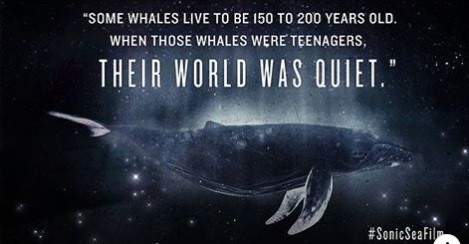
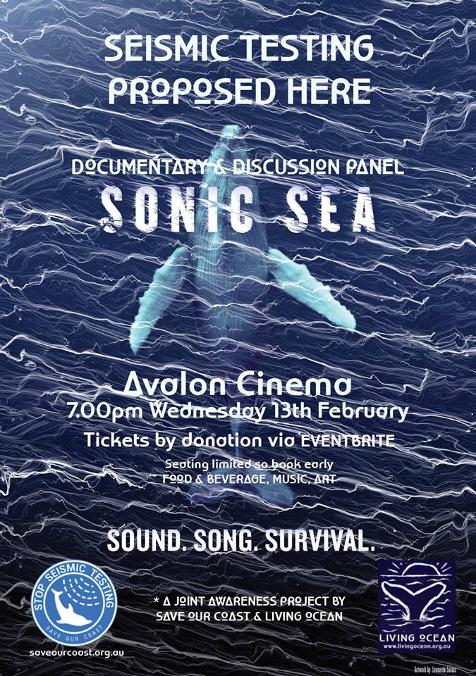
Dogs Must Be On Leash Sign Vandalised At Careel Creek
During the past week someone has spray painted black paint over the 'Dogs Must Be On a Leash' text on the dog sign at Careel Creek and the Yellow brick road.
The creek is visited by and home to ground dwelling bird species such Buff-banded Rail Gallirallus philippensis, the Mangrove or Striated Heron Butorides striata, duck species and their ducklings Australian Wood Duck Chenonetta jubata and Pacific Black Ducks, White-faced herons Egretta novaehollandiae, the Great egret Ardea alba, Bush-stone Curlew, Little Pied Cormorant Microcarbo melanoleucos and Royal spoonbill Platalea regia, while other bird species such live in or annually visit the trees and bushes that line the creek; the Dollarbird, Eurystomus orientalis, Glossy Black Cockatoo, Calyptorhynchus lathami and the tiny gregarious Brown Thornbill, Acanthiza pusilla to name a few.
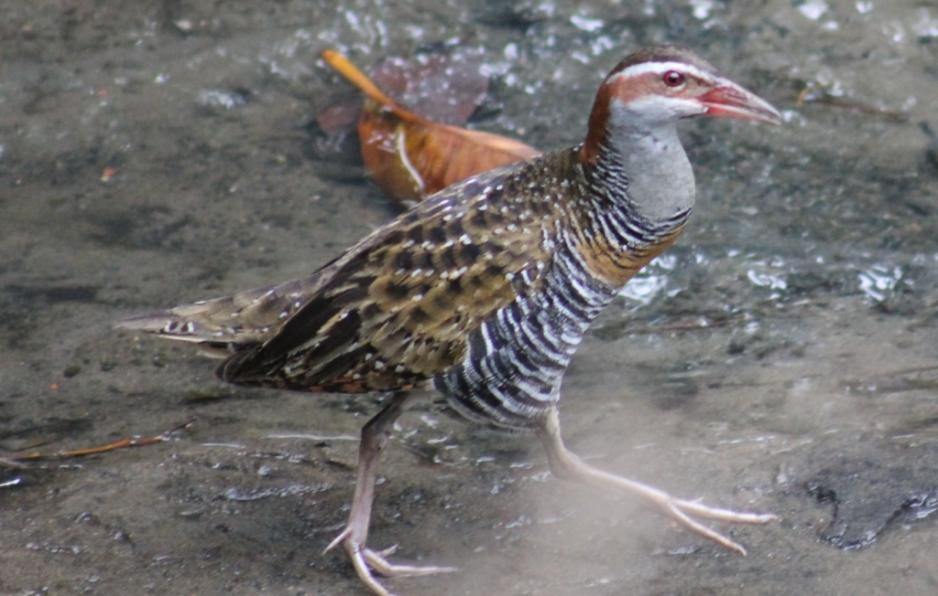
Buff-banded rail Gallirallus philippensis, Careel Creek
The stress caused to these native residents,in their home, by dogs chasing them or coming near their homes causes them to flee and repeated instances cause them to abandon an area altogether.
Just one study shows (Impacts of dogs on wildlife and water quality; Technical Report (PDF Available April 2016) -
Dogs (Canis lupus familiaris) are considered to be a subspecies of wolves (Canis lupus), and wildlife perceive dogs as predators.Impacts include: 1. Physical and temporal displacement – The presence of dogs causes wildlife to move away, temporarily or permanently reducing the amount of available habitat in which to feed, breed and rest. Animals become less active during the day to avoid dog interactions. Furthermore, the scent of dogs repels wildlife and the effects remain after the dogs are gone. 2. Disturbance and stress response – Animals are alarmed and cease their routine activities. This increases the amount of energy they use, while simultaneously reducing their opportunities to feed. Repeated stress causes long-term impacts on wildlife including reduced reproduction and growth, suppressed immune system and increased vulnerability to disease and parasites. 3. Indirect and direct mortality – Dogs transmit diseases (such as canine distemper and rabies) to and from wildlife. Loose dogs kill wildlife. 4. Human disease and water quality impacts - Dog waste pollutes water and transmits harmful parasites and diseases to people.
The penalty for chasing another animal (a bird for example) is 200 penalty units (BIG $$$$!) or 2 years imprisonment;
‘Dog rushes at, attacks, bites, harasses or chases any person or animal (other than vermin), whether or not any injury is caused to the person or animal as a result of a reckless act or omission by the dog’s owner or another person in charge of the dog at the time of the attack’ - Companion Animals Act - NSW
The following penalties apply to graffiti vandalism offences:- a maximum fine of $2,200 or imprisonment for 12 months for damaging or defacing property by means of any graffiti implement
- a maximum fine of $1,100 or imprisonment for 6 months for possessing a graffiti implement with the intention of damaging or defacing property
- imprisonment for up to 6 years for malicious damage involving graffiti.
A court can order an offender to undertake community clean up work instead of imposing a fine.
If you are the one who has done this - are you stating you want no dogs there at all or that dog owners should take their off-leash dogs into the creek area that is home to these birds?
If you are the one who has done this; do you live in peace and safety in your home?
If you are the one who has done this; do you think the next generation should get to see these other 'residents' in their natural habitat and have a moment brightened by their presence?

During the past week someone has spray painted black paint over the 'Dogs Must Be On a Leash' text on the dog sign at Careel Creek and the Yellow brick road.
The creek is visited by and home to ground dwelling bird species such Buff-banded Rail Gallirallus philippensis, the Mangrove or Striated Heron Butorides striata, duck species and their ducklings Australian Wood Duck Chenonetta jubata and Pacific Black Ducks, White-faced herons Egretta novaehollandiae, the Great egret Ardea alba, Bush-stone Curlew, Little Pied Cormorant Microcarbo melanoleucos and Royal spoonbill Platalea regia, while other bird species such live in or annually visit the trees and bushes that line the creek; the Dollarbird, Eurystomus orientalis, Glossy Black Cockatoo, Calyptorhynchus lathami and the tiny gregarious Brown Thornbill, Acanthiza pusilla to name a few.

Buff-banded rail Gallirallus philippensis, Careel Creek
The stress caused to these native residents,in their home, by dogs chasing them or coming near their homes causes them to flee and repeated instances cause them to abandon an area altogether.
Just one study shows (Impacts of dogs on wildlife and water quality; Technical Report (PDF Available April 2016) -
Dogs (Canis lupus familiaris) are considered to be a subspecies of wolves (Canis lupus), and wildlife perceive dogs as predators.
Impacts include:
1. Physical and temporal displacement – The presence of dogs causes wildlife to move away, temporarily or permanently reducing the amount of available habitat in which to feed, breed and rest. Animals become less active during the day to avoid dog interactions. Furthermore, the scent of dogs repels wildlife and the effects remain after the dogs are gone.
2. Disturbance and stress response – Animals are alarmed and cease their routine activities. This increases the amount of energy they use, while simultaneously reducing their opportunities to feed. Repeated stress causes long-term impacts on wildlife including reduced reproduction and growth, suppressed immune system and increased vulnerability to disease and parasites.
3. Indirect and direct mortality – Dogs transmit diseases (such as canine distemper and rabies) to and from wildlife. Loose dogs kill wildlife.
4. Human disease and water quality impacts - Dog waste pollutes water and transmits harmful parasites and diseases to people.
The penalty for chasing another animal (a bird for example) is 200 penalty units (BIG $$$$!) or 2 years imprisonment;
‘Dog rushes at, attacks, bites, harasses or chases any person or animal (other than vermin), whether or not any injury is caused to the person or animal as a result of a reckless act or omission by the dog’s owner or another person in charge of the dog at the time of the attack’ - Companion Animals Act - NSW
The following penalties apply to graffiti vandalism offences:
- a maximum fine of $2,200 or imprisonment for 12 months for damaging or defacing property by means of any graffiti implement
- a maximum fine of $1,100 or imprisonment for 6 months for possessing a graffiti implement with the intention of damaging or defacing property
- imprisonment for up to 6 years for malicious damage involving graffiti.
A court can order an offender to undertake community clean up work instead of imposing a fine.
If you are the one who has done this - are you stating you want no dogs there at all or that dog owners should take their off-leash dogs into the creek area that is home to these birds?
If you are the one who has done this; do you live in peace and safety in your home?
If you are the one who has done this; do you think the next generation should get to see these other 'residents' in their natural habitat and have a moment brightened by their presence?
Cholesterol Protein Discovery Raises Hope For Smarter Drugs
January 18, 2019: By Lachlan Gilbert, UNSW
A protein that transports cholesterol inside cells could be the key to developing drugs to boost ‘good cholesterol’.
Scientists at UNSW Sydney have made a breakthrough discovery about cholesterol transportation in cells that opens the way for new drugs to increase the body’s ‘good cholesterol’ levels.
And the knowledge could also be used to develop a new strategy to fight cancer.
Until now, drugs including statins – the most prescribed and profitable class of drugs in history – have targeted ‘bad cholesterol’, also known as LDL (low density lipoprotein), by inhibiting synthesis of it in the liver in an effort to mitigate risk of heart disease and stroke.
But while statins are effective at lowering LDL levels, they do little to increase the levels of good cholesterol, or HDL (high density lipoprotein), and there is no other drug in use that can significantly boost the human body’s HDL levels.
UNSW School of Biotechnology and Biomolecular Sciences Professor Rob Yang says that could all change because he and his team of researchers were able to identify a protein responsible for transporting cholesterol in a cell.
The molecule in question, a lipid transfer protein called ORP2, takes cholesterol from an animal cell’s organelles – or internal compartments – and delivers it to the cell’s surface membrane (also known as the plasma membrane), where cholesterol is used as a structural material to provide strength and flexibility.
Up to 90% of a cell’s cholesterol is found at the cell’s plasma membrane.
“HDL, the good cholesterol, is produced by the plasma membrane of the cell,” Professor Yang says. “When there is an abundance of cholesterol produced in the cell, some of it leaves the cell via the plasma membrane to form HDL which is then transported around the body.
“Knowing the molecules that deliver cholesterol to the plasma membrane itself is a huge step forward. The transport of cholesterol to the plasma membrane is the key to the generation of HDL.
“ORP2 can increase the amount of cholesterol that leaves the cell, a process called cholesterol efflux. We think this pathway will be very important for the development of a drug to increase this good cholesterol.”
Mystery solved
Professor Yang says the question of which protein is responsible for cholesterol transportation to the plasma membrane stumped scientists for many years.
“For a long time, cell biologists have been looking for the answer to a very simple question: how does cholesterol reach the plasma membrane? We know that 90% of cholesterol is found in the plasma membrane. We know that it is made in the endoplasmic reticulum or released from the lysosomes. But we haven’t known how it gets from the internal organelles to the plasma membrane where it is needed the most,” says Professor Yang.
“When we started this project, we were not sure we would find anything. So we were very excited, to say the least, to solve this mystery.”
Professor Yang says the new knowledge will allow cell biologists to focus on ORP2 with a view to increasing the amount of cholesterol delivered to the cell membrane, raising the amount leaving the cell to form HDL. One strategy could be to increase the number of ORP2 proteins in the cell, while another would be to improve the protein's efficiency.
Professor Yang says if such a drug could be developed, it would not replace statins, but would be used complementarily, with one drug used to reduce the bad cholesterol, and the other to increase levels of the good.
Cancer therapy
Another intriguing prospect raised by the research is that ORP2 could be targeted to fight cancer. The rampant and uncontrolled growth of cells that characterises cancer could be stopped in its tracks by reducing the amount of cholesterol produced, since this is vital for the structure of the cancer cell’s membrane.
“In many types of cancer cells, ORP2 is hyperregulated, given that so much more cholesterol would be needed to reach the plasma membrane for the rapid expansion of cancer cells,” Professor Yang says.
“But in cancer cells, you could shut this down. Perhaps if you block the function of this protein, you could stop the cells from growing and multiplying so fast.”
He says the idea that targeting cells’ cholesterol production isn’t new in the fight against cancer, but ORP2 could offer a new strategic line of research and possibly succeed where the use of statins in this area hasn’t.
But Professor Yang estimates it would be a good 10 years before these ideas led to the development of marketable pharmaceuticals. Until then, it is a long road of further research and development, finding the right strategy, screening potential compounds and then testing them in animal models.
The findings were reported in a paper published in Molecular Cell and highlighted in an article by Nature Reviews.
Small Mammals Digging Engineer Ecosystems
January 16, 2018: University of Tasmania
Small mammals digging for food play a vital role in ecosystems by enhancing soil fertility and condition, and helping to reduce bushfire risk, a new study has found.
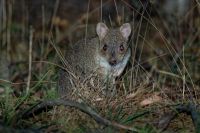 University of Tasmania School of Natural Sciences’ Masters student Gareth Davies worked with project lead Professor Chris Johnson and other researchers to measure the effects of digging by eastern bettongs, echidnas and other mammals on soil in temperate, dry forests in south-east Tasmania.
University of Tasmania School of Natural Sciences’ Masters student Gareth Davies worked with project lead Professor Chris Johnson and other researchers to measure the effects of digging by eastern bettongs, echidnas and other mammals on soil in temperate, dry forests in south-east Tasmania.Tasmania is the only State or territory in Australia which has large populations of species such as eastern bettongs, bandicoots and long-nosed potoroos.
The eastern bettong is extinct on mainland Australia, and the populations of two species of bandicoots and the long-nosed potoroo are declining.
“The impact of small animals digging on forest floors, turning soil over and trapping organic matter, is vital in helping to create and maintain a diverse ecosystem,” Professor Chris Johnson, from the University’s School of Natural Sciences, said.
The study found the digging by bettongs and other species created pits that act as traps for organic matter. Soil that formed as a result of breakdown of organic matter in the pits had higher fertility and moisture content and lower hardness than undisturbed topsoil.
More generally, medium-sized mammals that dig for their food in the ecosystems of mainland Australia have declined dramatically since European settlement, the study stated.
“Our data supports the hypothesis that the loss of digging species has changed soil characteristics, reduced soil fertility and degraded ecosystem functioning over large areas of Australia,” Professor Johnson said.
Key findings from the study include:
- the mammals dug foraging pits, which acted as traps for organic matter and sites for the formation of new soil which had higher fertility and moisture content and lower hardness than undisturbed topsoil;
- The traps, or patches, created habitats for invertebrates, which are vital for the regeneration of a forest’s ecosystem;
- The digging of holes, which houses organic matter and moisture in the soil, helps to reduce bushfire risk.
“The animals digging create higher moisture content in the soil, which not only helps to reduce the risk of bushfire but also enables the habitat to bounce back quickly if it is affected by fire,” Professor Johnson said.
“Digging mammals, such as the eastern bettong, provide a crucial element of ecological management and restoration of ecosystems.”
G. T. O. Davies , J. B. Kirkpatrick , E. Z. Cameron , S. Carver and C. N. Johnson. Ecosystem engineering by digging mammals: effects on soil fertility and condition in Tasmanian temperate woodland. Royal Society Open Science. Published:16 January 2019 https://doi.org/10.1098/rsos.180621
Victorian Game Management Authority Cuts Two Weeks Off Annual Duck Slaughter
Dry conditions lead to restrictions for 2019 duck season
January 17, 2019: Media Release
The Game Management Authority (GMA) has today outlined the arrangements for the 2019 duck hunting season including changes to the season length and the daily bag limit.
Prevailing and persistent dry conditions across eastern Australia has reduced duck numbers, breeding and wetland habitat in Victoria. As a result, the GMA advised the Victorian Government that a modified season was necessary to reduce the seasonal harvest, to ensure duck hunting is conducted responsibly and duck numbers remain sustainable.
The 2019 duck hunting season will be modified from twelve to nine weeks commencing on Saturday 16 March 2019 and closing on Sunday 19 May 2019.
Hunters will be restricted to four game ducks per day on the opening weekend, with a five game duck per day bag limit for the remainder of the nine week season. The hunting of Blue-winged Shoveler will again be prohibited throughout the entire season.
As per last year, hunting on the opening weekend of the 2019 season will commence at 9.00 am on Saturday and 8.00 am on Sunday across the whole of Victoria as part of a two-year trial of opening the season during daylight hours. For the rest of the season, hunting times will revert to the standard period of half an hour before sunrise to half an hour after sunset.
The settings for the 2019 duck season are based on analysis of habitat and waterbird surveys conducted across eastern Australia and other data relating to game duck abundance, habitat distribution and climate.
Hunters are reminded of the laws introduced last year requiring them to immediately retrieve all game ducks that they shoot and to at least salvage the breast meat from a duck to ensure that harvested game is not wasted. These laws formalised what is already standard practice for responsible hunters.
The GMA and partner agencies, including Victoria Police, Department of Environment, Land, Water and Planning, Department of Jobs, Precincts and Regions and Parks Victoria, will be out again in force in 2019 to ensure compliance with both hunting and public safety laws.
As in previous years, the GMA will continue to monitor conditions in the lead up to and during the season. Where warranted, wetlands may be closed to hunting to protect significant concentrations of waterbirds.
Details of the 2019 duck season, including fact sheets and information about any wetland closures throughout the season, will be available on the GMA website in due course.
____________
South Australia has authorised a 15-week open season in 2019, running from 16 March to 30 June, with a bag limit of eight birds per day. In New South Wales, where 79% of the state is affected by drought, licensed hunters are allowed to shoot ducks year round provided they have the landowner’s permission and don’t exceed quotas.
In NSW the Native game bird quotas, State-wide quota can include the following species:
- Australian Shelduck or Mountain Duck (Tadorna tadornoides)
- Australian Wood Duck or Maned Duck (Chenonetta jubata)
- Black Duck or Pacific Black Duck (Anas superciliosa)
- Blue-winged Shoveler or Australasian Shoveler (Anas rhynchotis)
- Chestnut Teal (Anas castanea)
- Grass Whistling Duck or Plumed Whistling Duck (Dendrocygna eytoni)
- Grey Teal (Anas gracilis)
- Hardhead Duck or White-eyed Duck (Aythya australis)
- Pink-eared Duck (Malacorhynchus membranaceus)
- Water Whistling Duck, Wandering Whistling Duck or Whistling or Wandering Tree Duck (Dendrocygna arcuata)
Licensed hunters who hold express authority to hunt native game birds are responsible for knowing the available allocation of game birds remaining for the land and to report their harvests to NSW DPI.
If an allocation has not been issued for a particular species, they may not be hunted in that year.
Allocation increases
The Wildlife Management Support Team monitors property allocations and hunter harvest returns on behalf of landholders - they will contact you if you are approaching the maximum harvest level and request you apply for an increase.
Ocean Giant Gets A Health Check: Going Vegan Due To Lack Of Fish
January 16, 2019: University of Tokyo
Whale sharks, the world's largest fish, likely endure periods of starvation and may eat more plants than previously thought, according to the first results of a new health check developed at the University of Tokyo. Ocean scientists now have a powerful, simple tool to discover the diets, migrations, and conservation needs of this endangered species.
Whale sharks are filter-feeding, soft-bodied fish that travel tropical oceans in search of their microscopic food. They grow 12 meters (39 feet) long and weigh 21 metric tons (46,297 pounds), about as long as a public city bus and as heavy as three African elephants. Despite their conspicuous size, many details of whale sharks' lives in the open ocean remain a mystery, even 183 years after they were first discovered.
The research team led by Alex Wyatt, a project researcher at the Atmosphere and Ocean Research Institute, carefully monitored the growth, diet, and health of three whale sharks living in an aquarium and two whale sharks living in ocean net cages.
"Whale sharks are one of the most exciting organisms to encounter for tourists and scientists alike, not just due to their sheer size, but also their grace and beauty. It is a privilege to unveil some of the mystery surrounding their lives," said Wyatt.
Traditionally, researchers track whale shark feeding by taking samples of different body tissues and analyzing the different forms, or isotopes, of carbon and nitrogen inside the tissues. Researchers realized that they could interpret tissue isotope levels correctly only if they knew each whale shark's history of growth and diet.
Tracking the growth and diet of wild whale sharks over time is impractical, so Wyatt used a blood test to complement tissue isotope analyses. Researchers take about 10 milliliters (2 teaspoons) of blood from one of the whale shark's pectoral fins. Scientists can analyze blood samples immediately on board a research ship, but tissue isotope analysis requires specialized laboratory equipment.
"Similar to blood tests performed when you visit the doctor, we are able to assess the health of whale sharks based on the contents of their blood," said Wyatt. "We combine blood tests and tissue isotope analyses to create an accurate health check for the animals."
The complete health check was given to eight wild whale sharks off the coast of Okinawa, Japan. Researchers collected samples while freeing whale sharks from accidental entanglement in fishing nets.
Several of the wild whale sharks may have not eaten for weeks or months, according to blood test results.
"Maybe they didn't encounter any food, or maybe they just do not eat while migrating long distances," said Wyatt.
Groups of whale sharks at coastal sites have been seen eating a range of prey, from tiny krill and fish eggs up to small fish and squid. A new finding of the health check is that all sharks tested showed signs of eating significant amounts of plants and algae.
"This is a somewhat surprising and controversial finding, since whale sharks are generally assumed to feed strictly on higher levels of the food chain. However, some whale sharks have been found with seaweed in their stomachs and eating plants might make sense if feeding opportunities can become as limited as our blood tests suggest," said Wyatt.
The health check and diet discoveries from wild Okinawan whale sharks may not be the same for other species, or possibly even other whale shark populations. However, Wyatt hopes that the complete health check approach will be used to investigate the possibility of starvation, individual foraging specialization, and unexpected food choices in a wide variety of other threatened marine animals.
Note: Whale sharks (Rhincodon typus) are listed as endangered on the International Union for Conservation of Nature Red List of Threatened Species.
Alex S.J. Wyatt, Rui Matsumoto, Yoshito Chikaraishi, Yosuke Miyairi, Yusuke Yokoyama, Keiichi Sato, Nao Ohkouchi, Toshi Nagata. Enhancing insights into foraging specialization in the world's largest fish using a multi-tissue, multi-isotope approach. Ecological Monographs, 2019 DOI: 10.1002/ecm.1339
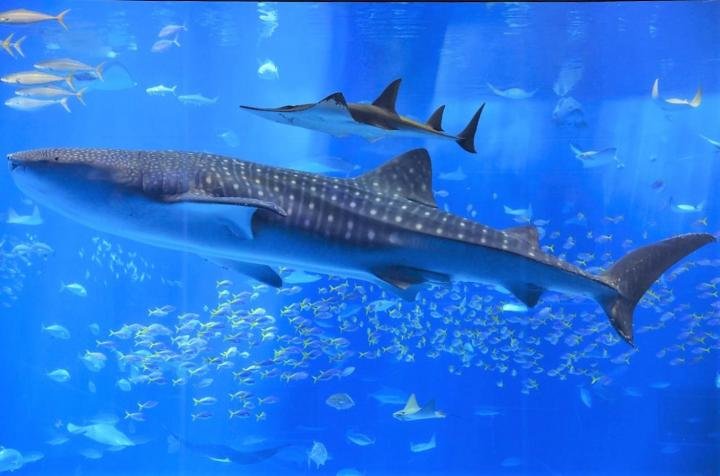
Whale sharks, like this individual at the Okinawa Churaumi Aquarium, are the world's largest species of fish, growing to 10 to 12 meters in length. Despite their large size and threatened status, whale shark ecology remains mysterious. A University of Tokyo research team led by Alex Wyatt, a project researcher at the Atmosphere and Ocean Research Institute, created a blood test and tissue isotope analysis health check to better understand the animals. Credit: Image by K. Sato, Okinawa Churashima Foundation Research Center CC-BY-NC-ND.
These Two Koalas Lost Their Mothers To Deforestation
I call on you to urgently end the deforestation and land-clearing crisis by making potential koala habitat, threatened species habitat, and other high-conservation-value areas off limits to clearing, and by repealing the land-clearing codes.
I also urge you to invest in a restoration and conservation fund and deliver the world-class mapping, monitoring, and reporting the community expects.
Smart Energy Conference & Exhibition 2019
Starts: 8:30am Tuesday, 2 April 2019
Ends: 5:30pm Wednesday, 3 April 2019
Location: International Convention Centre Sydney
14 Darling Drive, Darling Harbour, New South Wales 2000
Australia
The Smart Energy Conference and Exhibition is one of Australia’s biggest solar, storage and smart energy conference and exhibition.
Powered by the Smart Energy Council – incorporating the Australian Solar Council and Energy Storage Council, this is our 57th annual FREE-TO-ATTEND conference and exhibition.
TOP REASONS TO ATTEND
- Over 6,000 delegates, 120 exhibitors and partners
- A showcase of the latest technology, demonstration of new business models and innovation
- Outstanding knowledge sharing and networking
- 3 Conference and information sessions with over 100 presenters
- CPD points for installers
Long Reef Guided Reef Walks
Please find below the 2017 – 2018 timetable for guided walks of Long Reef Aquatic Reserve.
If you’d like to join us on a walk please contact me a couple of weeks before the walk date to make a booking. FREE GUIDED WALKS of Long Reef Aquatic Reserve with NSW Department of Industry & Investment Fishcare Volunteers will be held on the following date:
Dates for 2019
Sunday 6 January 2019 3:00pm – 5:00pm
Sunday 20 January 2019 2:00pm – 4:00pm
Sunday 17 February 2019 1:00pm – 3:00pm
Sunday 17 March 2019 11:30am – 1:30pm
Sunday 7 April 2019 2:30pm – 4:30pm
Walks are held subject to weather conditions
Bookings are preferred.
Please email Wendy to book:
Tufted Duck At Werribee
BirdLife Australia: January 17, 2019
A single Tufted Duck has been seen at the Western Treatment Plant, south-west of Melbourne, and it’s the first time the species has been recorded in Australia.
The bird was first seen by a visiting American birder on 3 January, and a twitching tsunami was unleashed. Within hours of the sighting, dozens of people had ventured to the WTP for a glimpse of the bird, and since then it has been seen by hundreds of twitchers from across the country, all keen to add a new bird to their list. Unlike many visiting rarities, this bird has stayed put — at least for the moment!
What makes this Tufted Duck so special is that it is so very far away from where it should be.
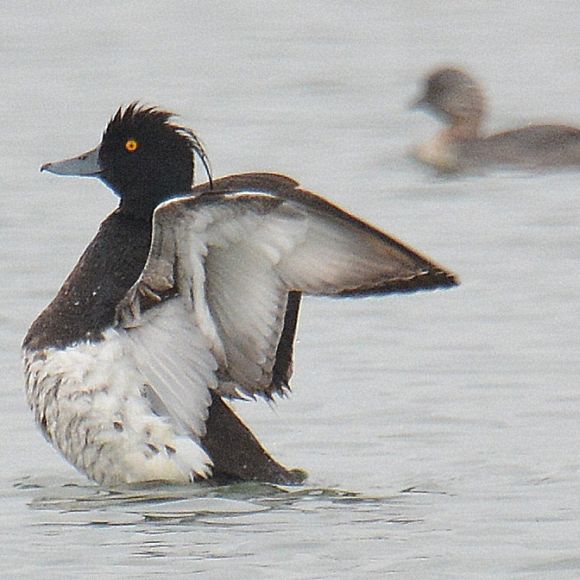
Tufted Duck photo by Warren Palmer
The Tufted Duck is a strictly a Northern Hemisphere species (a least until now), and nests in northern parts of Eurasia, in a belt that extends from Iceland and Ireland, across northern continental Europe, east to eastern Siberia. The species is migratory, so that at the end of the breeding season, as the days begin to grow shorter, flocks of Tufted Ducks leave their nesting grounds, flying south to eastern and southern Asia (but not as far as South East Asia, though a couple of vagrants have been recorded in West Papua), as well as Mediterranean Europe and Africa.
So what’s this one doing in Australia? It seems that this particular duck undertook its usual annual migration but then got carried away, presumably reaching its usual ‘wintering’ grounds — but then it kept on flying until it reached Australia. And then kept on flying further still, until it finally reached the Western Treatment Plant. This bird is clearly a really long way off course.
While at the Western Treatment Plant, the Tufted Duck has been regularly seen diving for food — mostly invertebrates and aquatic plants — a habit which adds to the degree of difficulty for people trying to spot it through the heat haze.
People wishing to see the Tufted Duck should be aware that it is on Melbourne Water land, and all birdwatchers need a permit to visit the site. And anyone who wants to tick off the Tufted Duck on their life list must also be patient, as it is invariably among the myriad other ducks that have congregated at the Western Treatment Plant to escape the ravages of the ongoing drought.
The WTP has long been recognised as a major drought refuge for waterfowl, and Melbourne Water is to be congratulated for maintaining the Plant as superb habitat for ducks as well as other aquatic and wading species.
Woodside Scarborough Project: Have Your Say
Oil and gas company Woodside Energy has applied for federal approval for dredging and pipeline construction in waters near the Western Australian Dampier Archipelago marine reserves.
The company sought the approval as part of its proposed Scarborough gas project, an offshore development about 380km from the Burrup peninsula that would use a 430km pipeline to transport gas to its existing Pluto liquefied natural gas facility on the peninsula.
A development proposal for the state waters component of the project was published by the federal environment department on Christmas Eve. Under environment protection and biodiversity conservation regulations the public has only 10 business days to comment once a referral is published.
The Refrral was listed on the EPBC website on December 24th, 2018. Following a public backlash, the end date for having your say was then extended by Federal Environment Minister Melissa Price until January 31st.
Other components of the Scarborough project, including those in commonwealth waters, will be the subject of separate applications to other government agencies, including the National Offshore Petroleum Safety and Environmental Management Authority.
The proposal includes the dredging of up to 2,781,700 m3 of the sea floor of Mermaid Sound – up to 1,612,600 m3 of which will be located in state waters – for the installation of 32.7km of steel pipeline adjacent to an existing trunkline.
From the document:
The proposed extent of physical and operational elements are detailed below:
-Trenching, pipelay and backfill activities for the installation of the trunkline including: Dredging of maximum 2,781,700 m3 during the trenching for the trunkline, of which a maximum of 1,612,600 m3 will be in State Waters. The volumes would be confirmed during detailed engineering design.
Installation of the pipe up to Kilometre Point (KP) 0, 1.5m above Highest Astronomical Tide (HAT), the exact location may vary slightly but will remain within the referred proposal development envelope. A 32 inch carbon steel trunkline 32.7 kilometres long installed in a trench around 2–4.3 metres deep and up to 30 m wide. The trench would be backfilled with sand and/or rock material for stabilisation purposes along the trunkline as required.
Concrete blocks backfilled with trenching material may also be required to provide reaction forces. These would be laid within the trench footprint and retained in place to maintain the reaction forces once the pipe is laid. The trench backfilling operations will cover these blocks on completion of the construction works.
-The use of existing spoil grounds within State Waters for disposal of dredged sediments. Spoil from the trunkline dredging operations will be placed in a combination of the spoil grounds listed below. The final spoil ground locations are subject to further engineering design and consultation with relevant stakeholders.
- Spoil Ground A/B (restricted to backhoe works) and 2B located in State Waters.
- Spoil Ground 5A located in Commonwealth Waters (Provided for information only but not assessed as part of this referral)
-The potential use of an existing borrow ground within State Waters, to obtain sediment for trunkline stabilisation activities.
Sand and Rock materials may be required to assist with trunkline stabilisation. Sand is proposed to be obtained from borrow ground locations located in either State or Commonwealth waters. Rocks would be obtained from domestic or international sources.
-The installation of temporary facilities along the shoreline at the Pluto LNG Facility to facilitate the installation of the trunkline in shallower depth and the connection to the Facility.
A temporary groyne around 100 metres long would be constructed on the shoreline between the pre-excavated trench and the Pluto jetty to allow excavating equipment to access and excavate the rock berm currently covering the trench. A suitable storage location will be required for the excavated rock assuming that this rock will be used to reinstate the shore crossing rock berm following trunkline installation. Piles may also be required to anchor the nearshore pipelay barge. Piles are required due to the proximity to the Pluto trunkline which may prevent the use of anchors for the pipelay activities. It’s estimated a total of 8 driven piles may be required.
Space would be required at the shore crossing location for temporary offices, cranes and other equipment for the shore pull of the trunkline.
Woodside states it believes the proposal does not require a full assessment under the Environment Protection and Biodiversity Conservation Act because it “does not consider that the elements of the proposal that have been assessed, involve an action that is likely to have a significant impact upon matters of national environmental significance (MNES) or other protected matters”.
The document says the company had assessed the potential for direct and indirect impacts on the Dampier Archipelago, located 1.6km from the proposed pipeline at its nearest point, and found potential for indirect impacts on water quality as a result of dredging.
The proposal also states marine species could be affected, including the endangered loggerhead turtle which has been found in locations that intersect with some of the development area. Direct risks included “vessel strikes and/or entrainment during dredging”.
Invitations for public comment: EPBC
Ensuring your comments are effective
- Clearly reference the referral (EPBC number and proposal title) in your submission.
- State clearly whether, and how, you believe the proposal would have a significant impact on matters protected by the EPBC Act. The Minister, or their delegate, can only take into account comments, concerns or issues in respect to the specific matters of national environmental significance or matters protected under the EPBC Act. Be specific by stating which aspects of the proposal would impact on matters (e.g. a particular listed species or heritage value).
- If you believe the information in the referral is misleading or incorrect, you should state the reasons why and provide correct information, if available.
- Give the source of any key information used in reaching your conclusion.
- Provide clear contact details if the Department needs to get in touch with you to seek clarification.
- Provide comments by the due date. If your comments are going to be late, please contact the Department before the due date, and advise of your intention to provide comment, and the date the comment will be provided. The Department will advise you if the comments can be accepted.
Please note: Submissions may be subject to release under the Freedom of Information Act 1982, and may be provided to third parties for procedural fairness purposes (also known as natural justice).
Public submissions are not normally confidential, however if you wish your submission to be treated by the Department as confidential, please mark it clearly as 'confidential' and provide your reasons for it to be considered as such. The Department will use its best endeavours to deal with the submission accordingly but this does not make it automatically exempt from release.
If you require further information contact the Referrals Gateway on 02 6274 2496 or email epbc.referrals@environment.gov.au.
Submitting your comments
Please send your comments on referrals quoting the reference number and title of the referral to:
Or post (allowing for the public comment due date):
Referrals Gateway
Assessment & Governance Branch
Department of the Environment and Energy
GPO Box 787
Canberra ACT 2601
Woodside Scarborough docs at: http://epbcnotices.environment.gov.au/invitations/
Reference No. 2018/8362
Title of referral: WOODSIDE ENERGY LTD./Mining/Seabed within State Waters and within Port of Dampier limits/Western Australia/Scarborough Development nearshore component, NWS, WA
AGL Admits It Has Been Selling Ash With Unacceptable Levels Of Heavy Metal Contamination
January 17, 2019: Media Release - NSW Conservation Council
AGL’s admission that it has been selling contaminated waste to business customers highlights the need to tighten environmental controls on the state’s most polluting industry. [1]
The fossil fuel giant suspended sale of coal ash from its Liddell and Bayswater power stations after tests showed elevated levels of heavy metals (chromium, cadmium and copper) exceeded limits set by the NSW Environment Protection Authority.
“The tsunami of waste generated by coal-fired power stations is leaving an immense toxic legacy for future generations to deal with, especially in the Hunter Valley and on the Central Coast,” Nature Conservation Council Senior Climate and Energy Campaigner Brad Smith said.
“About 5.8 million tonnes of toxic coal ash are produced by coal-fired power stations every year in Australia, which is 22 per cent of all the nation’s waste.
“Last year we learned the ash dam at the Eraring power station was leaching toxins into Lake Macquarie after its owner, Origin Energy, announced plans to dump a further 5 million cubic metres of ash close to the lake. [2]
“Now we are told contaminated waste from AGL plants has been spreading through the community embedded in the products that use ash as an ingredient.
“AGL says the products do not pose a public health risk, but the company had also led us to believe until today that the ash it was selling met government standards.
“It is unclear at this stage how long the company has been selling contaminated waste or what volume of material has found its way out into the wider community.
“We urge the government make the company fully disclose the level of contamination and track the likely final destination of these contaminants so consumers can protect themselves.
“This incident is another reminder that we should shut these dangerous facilities as soon as we can and start generating all our electricity using energy from the sun and wind.”
REFERENCES
[1] www.agl.com.au/about-agl/media-centre/asx-and-media-releases/2019/january/agl-suspends-coal-ash-from-sale
[2] www.theherald.com.au/story/5685400/contamination-fears-rising-as-eraring-power-station-gets-approval-to-augment-ash-dam/
The Darling River Is Simply Not Supposed To Dry Out, Even In Drought
January 16, 2019
by Fran Sheldon
Professor, Australian Rivers Institute, Griffith University, Griffith University
The deaths of a million of fish in the lower Darling River system over the past few weeks should come as no surprise. Quite apart from specific warnings given to the NSW government by their own specialists in 2013 *, scientists have been warning of devastation since the 1990s.
Put simply, ecological evidence shows the Barwon-Darling River is not meant to dry out to disconnected pools – even during drought conditions. Water diversions have disrupted the natural balance of wetlands that support massive ecosystems.
Unless we allow flows to resume, we’re in danger of seeing one of the worst environmental catastrophes in Australia.
Dryland river
The Barwon-Darling River is a “dryland river”, which means it is naturally prone to periods of extensive low flow punctuated by periods of flooding.
However, the presence of certain iconic river animals within its channels tell us that a dry river bed is not normal for this system. The murray cod, dead versions of which have recently bought graziers to tears and politicians to retch, are the sentinels of permanent deep waterholes and river channels – you just don’t find them in rivers that dry out regularly.
Menindee resident Dick Arnold and Rob McBride (Tolarno Station) stand in the Darling River above weir 32 each holding a 100 hundred year old Murray Cod.
Less conspicuous is the large river mussel, Alathyria jacksoni, an inhabitant of this system for thousands of years. Its shells are abundant in aboriginal middens along the banks. These invertebrates are unable to tolerate low flows and low oxygen, and while dead fish will float (for a while), shoals of river mussels are probably dead on the river bed.
This extensive drying event will cause regional extinction of a whole raft of riverine species and impact others, such as the rakali. We are witnessing an ecosystem in collapse.
Catastrophic drying
We can see the effects of permanent drying around the world. The most famous example is the drying of the Aral Sea in Central Asia. Once the world’s fourth largest inland lake, it was reduced to less than 10% of its original volume after years of water extraction for irrigation.
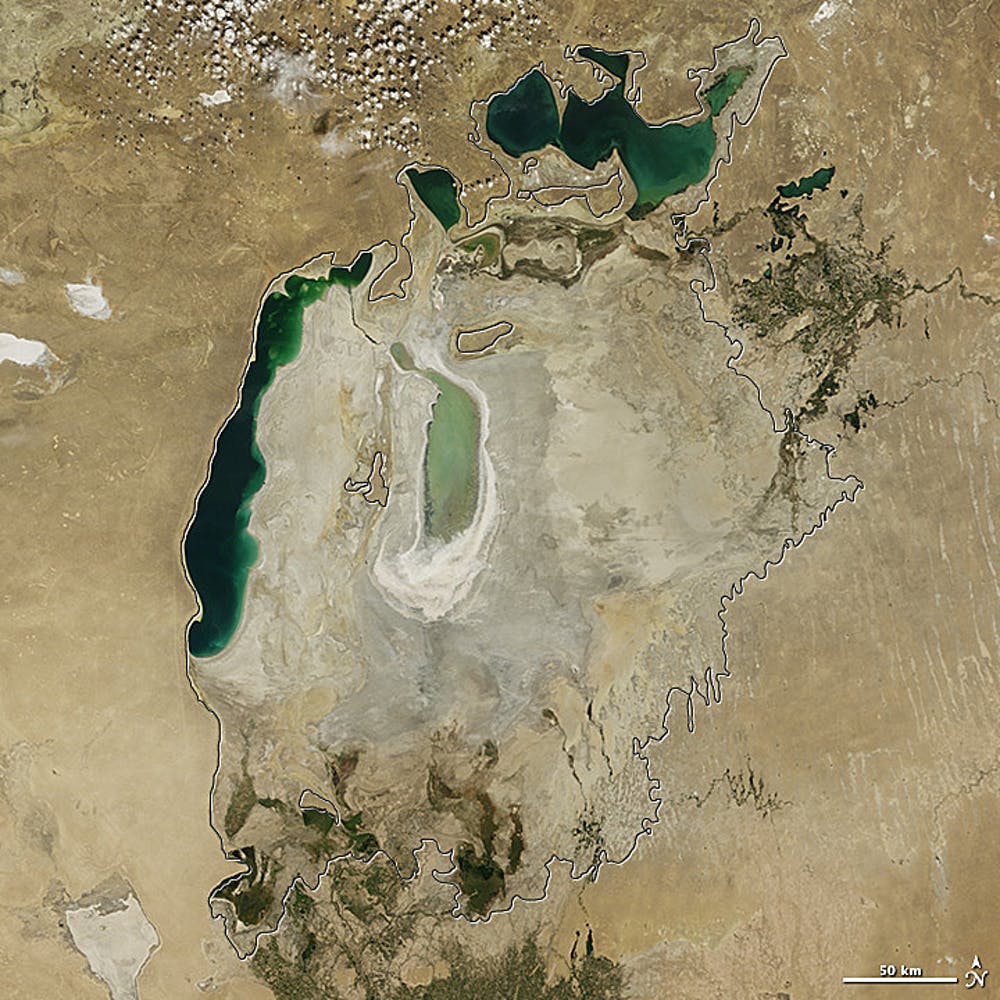
The basin that once held the Aral Sea. The giant lake has shrunk dramatically since dams were built around it in the 1960s. AAP Image/NASA Earth Observatory
The visual results of this exploitation still shock: images of large fishing boats stranded in a sea of sand, abandoned fishing villages, and a vastly changed microclimate for the regions surrounding the now-dry seabed. Its draining has been described as “the world’s worst environmental disaster”.
So, what does the Aral Sea and its major tributaries and the Darling River system with its tributary rivers have in common? Quite a lot, actually. They both have limited access to the outside world: the Aral Sea basin has no outflow to the sea, and while the Darling River system connects to the River Murray at times of high flow, most of its water is held within a vast network of wetlands and floodplain channels. Both are semi-arid. More worryingly, both have more the 50% of their average inflows extracted for irrigation.
There is one striking difference between them. The Aral Sea was a permanent inland lake and its disappearance was visually obvious. The wetlands and floodplains of the Barwon-Darling are mostly ephemeral, and the extent of their drying is therefore hard to visualise.
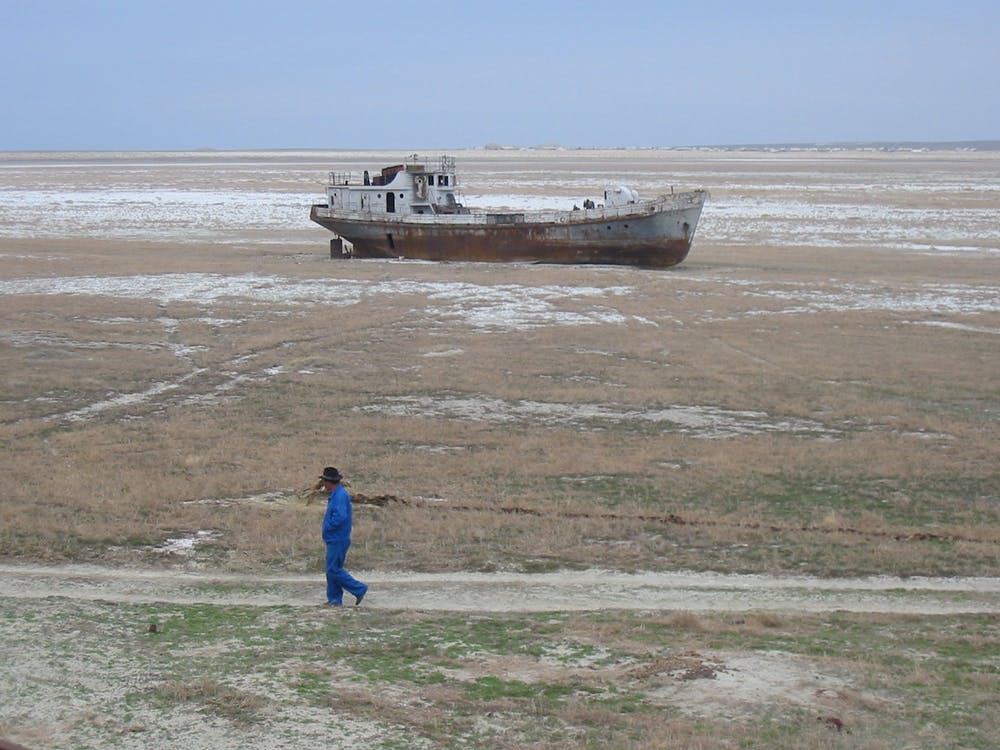
An orphaned ship in former Aral Sea, near Aral, Kazakhstan. Wikipedia
All the main tributaries of the Darling River have floodplain wetland complexes in their lower reaches (such as the Gwydir Wetlands, Macquarie Marshes and Narran Lakes). When the rivers flow they absorb the water from upstream, filling before releasing water downstream to the next wetland complex; the wetlands acting like a series of tipping buckets. Regular river flows are essential for these sponge-like wetlands.
So, how has this hydrological harmony of regular flows and fill-and-spill wetlands changed? And how does this relate to the massive fish kills we are seeing in the lower Darling system?
While high flows will still make it through the Barwon-Darling, filling the floodplains and wetlands, and connecting to the River Murray, the low and medium flow events have disappeared. Instead, these are captured in the upper sections of the basin in artificial water storages and used in irrigation.
This has essentially dried the wetlands and floodplains at the ends of the tributaries. Any water not diverted for irrigation is now absorbed by the continually parched upstream wetlands, leaving the lower reaches vulnerable when drought hits.
By continually keeping the Barwon-Darling in a state of low (or no) flow, with its natural wetlands dry, we have reduced its ability to cope with extended drought.
While droughts are a natural part of this system and its river animals have adapted, they can’t adjust to continual high water caused in some areas by water diversions – and they certainly can’t survive long-term drying.
The Basin Plan has come some way in restoring some flows to the Barwon-Darling, but unless we find a way to restore more of the low and medium flows to this system we are likely witnessing Australia’s worst environmental disaster.
This article is republished from The Conversation under a Creative Commons license. Read the original article.
FACEBOOK POST BY Michael Daley, Opposition Leader in the NSW Parliament and the leader of the NSW Labor Party.
January 13, 2019
SECRET DOCUMENT: The NSW Liberal-Nationals were warned in confidential documents written in March 2012 that their changes to water usage rules could cause significant damage to the Murray Darling and kill fish.
Despite these warnings, six months later in October 2012 the Liberal-Nationals changed the water rules.
This revelation comes after the environmental catastrophe that has killed up to a million fish and seen water quality deteriorate in the Darling River in the state’s far west.
I am determined to get to the bottom of this scandal.
A Labor Government’s first step will be a Special Commission of Inquiry into water management on the Barwon Darling River System. It will have Royal Commission-like powers.
I will overhaul the water rules where necessary.
Source document (March 2012) obtained through freedom of information laws:
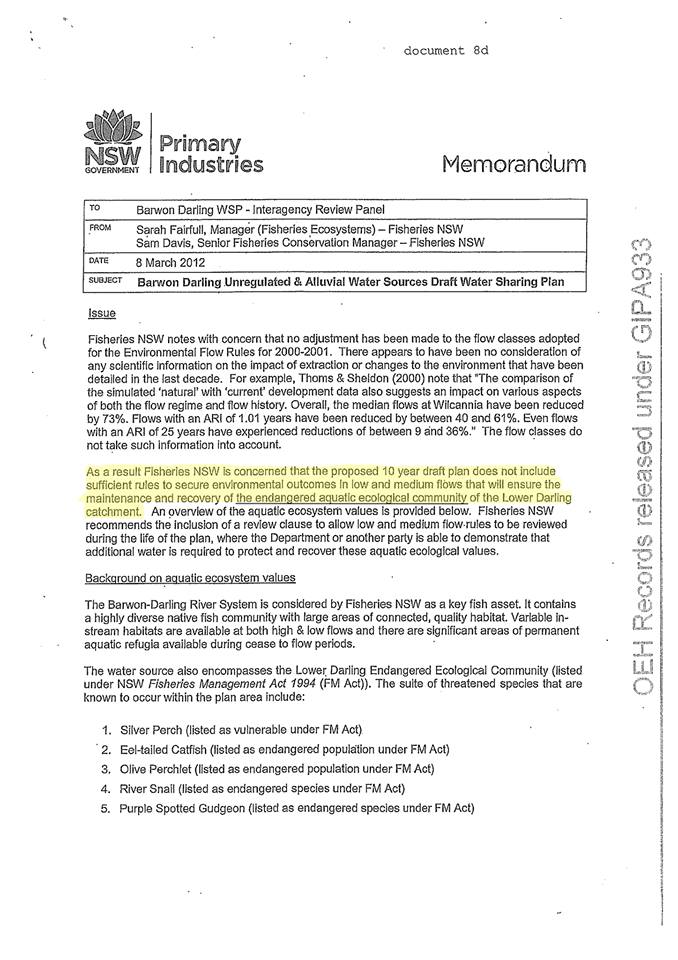
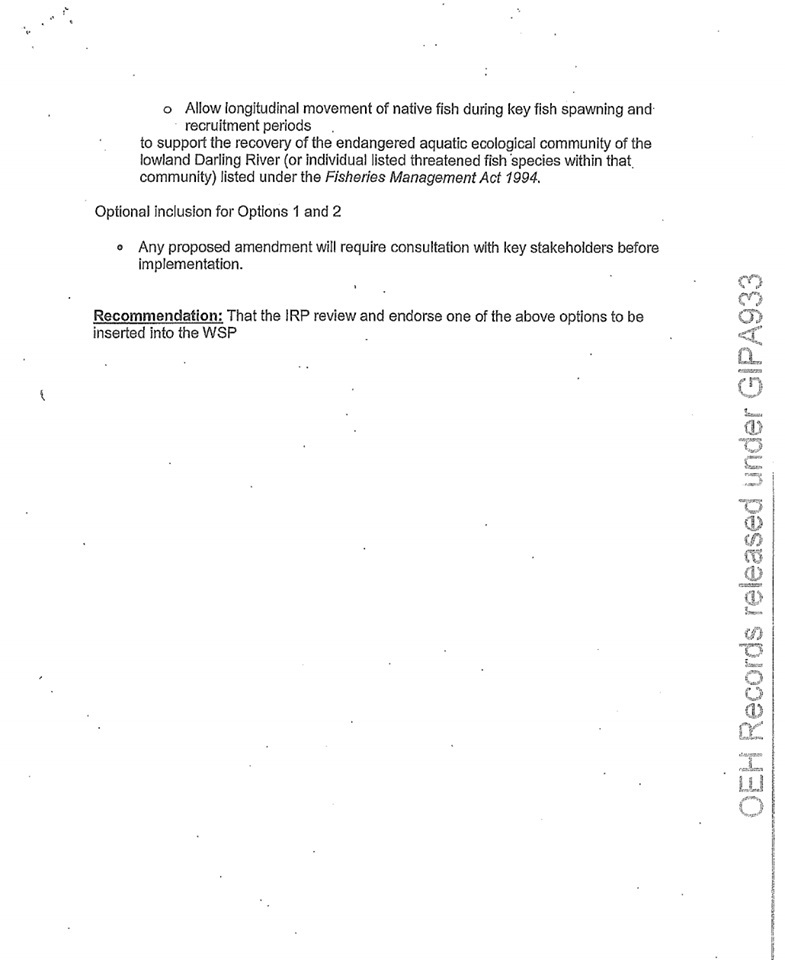
Background Information - Visit:
- Water Sharing Plan for the Barwon-Darling Unregulated and Alluvial Water Sources 2012
- Pumped, reported by Linton Besser and presented by Sarah Ferguson - ABC 4 Corners, 25th July, 2017
- Response from NSW Department of Primary Industries (on 'Pumped'), NSW DPI STATEMENT. Note: This statement has been edited for privacy reasons.
- NSW minister altered Barwon-Darling water-sharing plan to favour irrigators by Anne Davies, February 8, 2018 The Guardian
- How is oxygen ‘sucked out’ of our waterways? - January 14, 2019 by Stuart Khan, Professor of Civil & Environmental Engineering, UNSW
NSW Government Allows Shenhua To Start Work On Liverpool Plains Mine Without Crucial Management Plans
January 08, 2019: Media Releazse - Lock the Gate
The NSW Government has allowed mining company Shenhua to alter its development approval for the controversial Watermark open cut coal mine in the Liverpool Plains, near Gunnedah, which will enable work on site to begin without key management plans being approved.
Despite the NSW deal, Shenhua is still not able to commence work under the Federal environmental approval until two important management plans, including the crucial Water Management Plan, have been approved by the Federal Government.
Now local farmers are afraid that the Federal Environment Minister, Melissa Price, may be about to follow the NSW Government lead and vary the approval to allow Shenhua to start pre-construction for their mine without the management plans that were promised.
Liverpool Plains farmer John Hamparsum said, “We’re disgusted that the NSW Government has capitulated to Shenhua yet again, and amended the development consent to let them start pre-construction work without the crucial Water Management Plan in place.
"They have repeatedly stated that the best science would apply to this mine before any work was done, and now they’ve thrown that out the window.
"We’re calling on the Federal Environment Minister, Melissa Price, and New England MP, Barnaby Joyce to now step up and promise that not a sod will be turned on this mine until the full Water Management Plan has been developed and reviewed by independent scientists.
"This mine represents a massive threat to our water resources and our capacity to feed Australia, and if the National Party has any respect for agriculture they need to act now and deliver on their promise that the best science will be applied.
"We won’t accept creeping development of this mine and weakening of the conditions that were put in place to protect our precious groundwater," he said.
Lock the Gate Alliance spokesperson Georgina Woods said, "It’s been four years since the NSW and Federal Governments approved Shenhua’s Watermark coal mine on the Liverpool Plains and there are still no management plans in place.
"Instead of upholding the conditions of Shenhua’s approval, the NSW Government has watered them down so that Shenhua can start work without these crucial plans in place.
"The community has a long memory and will not accept Governments changing the rules to the benefit of foreign-owned mining giants over local farmers," she said.
The former Federal Environment Minister, Greg Hunt, made a strong commitment that a Water Management Plan for the project would not be approved unless the Independent Expert Scientific Committee was satisfied with it.
Fifty Years Of Decline In Queensland's Coastal Sharks
December 13, 2018: University of Queensland
Queensland's coastal shark numbers are continuing a 50-year decline, in sharp contradiction of suggestions of 'exploding' shark populations, according to an analysis of Queensland Shark Control Program data.
University of Queensland and Griffith University researchers analysed data from the program, which has used baited drumlines and nets since 1962 to minimise human-shark interactions, and now spans 1760 km of the Queensland coastline.
UQ School of Biological Sciences researcher Dr George Roff said historical baselines of Queensland shark populations were largely unknown, despite a long history of shark exploitation by recreational and commercial fisheries.
"Explorers in the 19th century once described Australian coastlines as being 'chock-full of sharks', yet we don't have a clear idea of how many sharks there used to be on Queensland beaches," he said.
"Shark populations around the world have declined substantially in recent decades, with many species being listed as vulnerable and endangered."
By analysing the Queensland Shark Control Program data, the research team reconstructed historical records of shark catches to explore changes in the number and sizes of sharks over the past half century.
"What we found is that large apex sharks such as hammerheads, tigers and white sharks, have declined by 74 to 92 per cent along Queensland's coast," Dr Roff said.
"And the chance of zero catch -- catching no sharks at any given beach per year -- has increased by as much as seven-fold.
"The average size of sharks has also declined -- tiger sharks and hammerhead sharks are getting smaller."
"We will never know the exact numbers of sharks in our oceans more than half a century ago, but the data points to radical changes in our coastal ecosystems since the 1960s.
"The data acts as a window into the past, revealing what was natural on our beaches, and provides important context for how we manage sharks.
"What may appear to be increases in shark numbers is in reality a fraction of past baselines, and the long-term trend shows ongoing declines.
"While often perceived as a danger to the public, sharks play important ecological roles in coastal ecosystems.
"Large apex sharks are able to prey on larger animals such as turtles, dolphins and dugongs, and their widespread movement patterns along the coastline connects coral reefs, seagrass beds and coastal ecosystems.
"Such losses of apex sharks is likely to have changed the structure of coastal food webs over the past half century."
George Roff, Christopher J. Brown, Mark A. Priest, Peter J. Mumby. Decline of coastal apex shark populations over the past half century. Communications Biology, 2018; 1 (1) DOI: 10.1038/s42003-018-0233-1
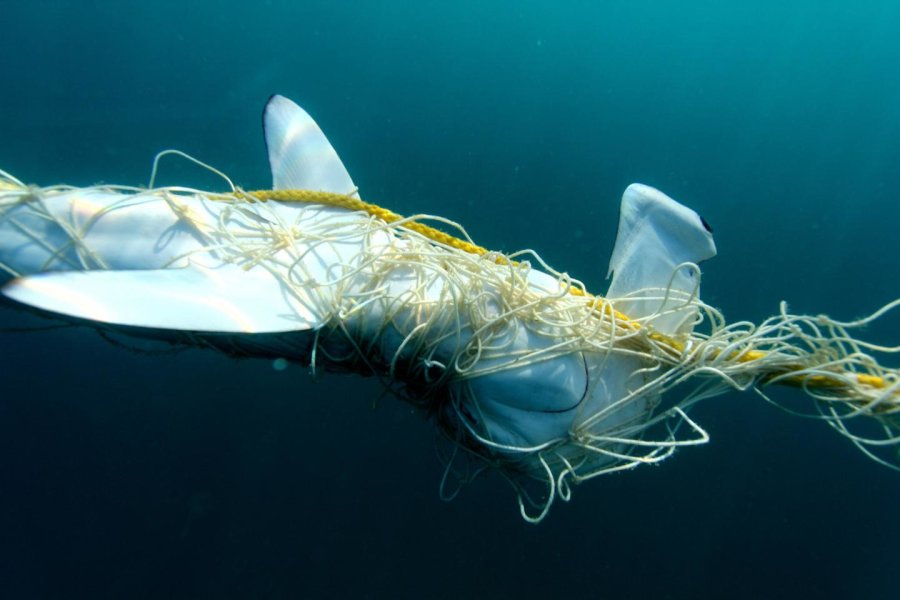
This is a hammerhead shark entangled in a Queensland Shark Control Program net at Magnetic Island in Queensland, Australia. Credit: Nicole McLachlan
Ultra Ultrasound To Transform New Tech
January 16, 2019: University of Queensland
A new and extremely sensitive method of measuring ultrasound could revolutionise everything from medical devices to unmanned vehicles.
Researchers at The University of Queensland have combined modern nanofabrication and nanophotonics techniques to build the ultraprecise ultrasound sensors on a silicon chip.
Professor Warwick Bowen, from UQ's Precision Sensing Initiative and the Australian Centre for Engineered Quantum Systems, said the development could usher in a host of exciting new technologies.
"This is a major step forward, since accurate ultrasound measurement is critical for a range of applications," he said.
"Ultrasound is used for medical ultrasound, often to examine pregnant women, as well as for high resolution biomedical imaging to detect tumours and other anomalies.
"It's also commonly used for spatial applications, like in the sonar imaging of underwater objects or in the navigation of unmanned aerial vehicles.
"Improving these applications requires smaller, higher precision sensors and, with this new technique, that's exactly what we've been able to develop."
The technology is so sensitive that it can hear, for the first time, the miniscule random forces from surrounding air molecules.
"We've developed a near perfect ultrasound detector, hitting the limits of what the technology is capable of achieving," Professor Bowen said.
"We're now able to measure ultrasound waves that apply tiny forces -- comparable to the gravitational force on a virus -- and we can do this with sensors smaller than a millimetre across."
Research leader Dr Sahar Basiri-Esfahani, now at Swansea University, said the accuracy of the technology could change how scientists understand biology.
"We'll soon have the ability to listen to the sound emitted by living bacteria and cells," she said.
"This could fundamentally improve our understanding of how these small biological systems function.
"A deeper understanding of these biological systems may lead to new treatments, so we're looking forward to seeing what future applications emerge."
Sahar Basiri-Esfahani, Ardalan Armin, Stefan Forstner, Warwick P. Bowen. Precision ultrasound sensing on a chip. Nature Communications, 2019; 10 (1) DOI: 10.1038/s41467-018-08038-4
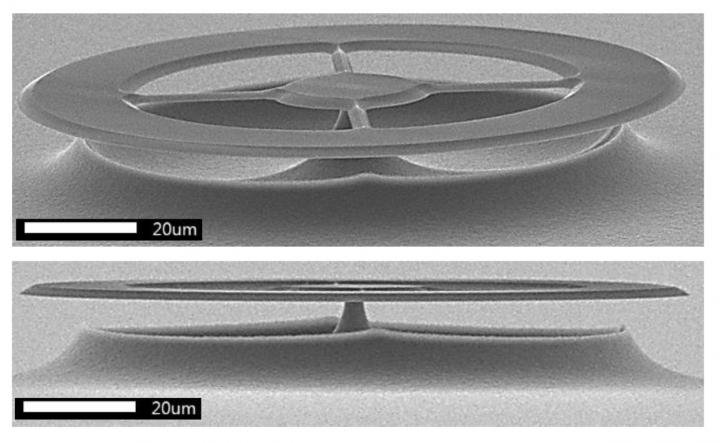
A scanning electron micrograph of a microdisk similar to the one researchers used to create their new ultrasound sensor. Credit: The University of Queensland
Vampire Bat Venom Could Hold Key To New Medical Treatments
January 16, 2019: University of Queensland
An international team led by The University of Queensland has found a new class of blood pressure-regulating peptides in the venom of the common vampire bat (Diphylla ecaudata).
UQ School of Biological Sciences researcher Associate Professor Bryan Fry said the peptides could help revolutionise treatments for a wide range of conditions, including hypertension, heart failure, kidney diseases and burns, but the research had been hampered by criminal activity at a Mexican field site.
"The peptides are mutated forms of the Calcitonin Gene Related Peptide (CGRP), used by our bodies to relax blood vessels," he said.
"The peptides from the bats are unusually selective in their mode of action, making them even more therapeutically useful than the CGRP, as they have fewer side-effects.
"This could potentially help doctors in the treatment of a range of disorders featuring heightened pressure in small blood vessels, or may be able to improve blood flow to damaged or transplanted tissue such as skin grafts."
Associate Professor Fry said there was much more to be learned than feared from the unique but much maligned vampire bats.
"This discovery is another example of why it's so important to broadly protect nature, since we can't predict where the next great biologically sourced drug discovery is going to come from," he said.
"Venomous animals around the world are under threat, even more so than most other threatened or endangered species, due to deliberate persecution driven by fear or misunderstanding."
Associate Professor Fry said his team was facing challenges accessing vampire bat specimens.
"We can't access our original field site in Mexico anymore, because we're told that region has been taken over by drug traffickers," he said.
"It's now too dangerous for even my Mexican colleagues to go there, let alone a gringo like me.
"We'll have to find new field sites that are safe to work in, but once we do that we'll be on track to find new peptide variations and potential wonder drugs, helping improve and save lives."
Rahini Kakumanu, Wayne Hodgson, Ravina Ravi, Alejandro Alagon, Richard Harris, Andreas Brust, Paul Alewood, Barbara Kemp-Harper, Bryan Fry. Vampire Venom: Vasodilatory Mechanisms of Vampire Bat (Desmodus rotundus) Blood Feeding. Toxins, 2019; 11 (1): 26 DOI: 10.3390/toxins11010026
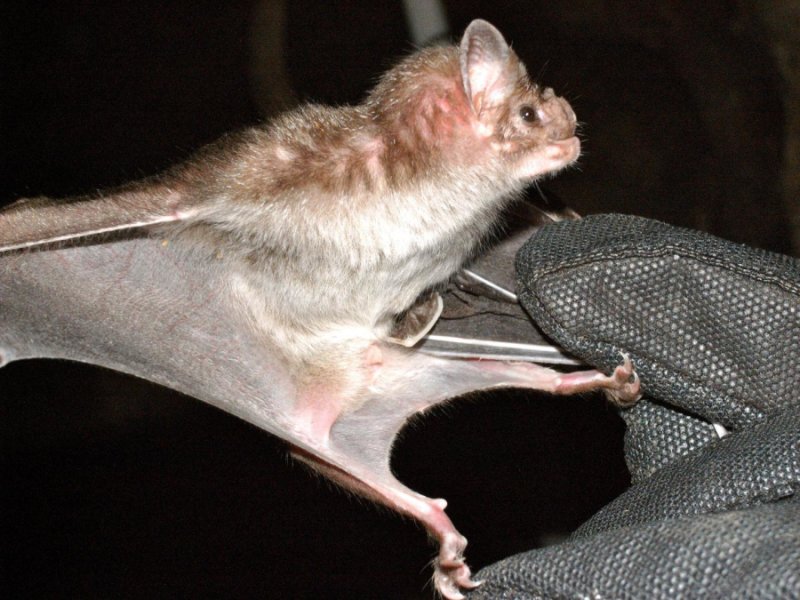
A vampire bat at the field site near Cuernavaca, Mexico. Credit: Bryan Fry
Scientists Grow Perfect Human Blood Vessels In A Petri Dish
January 16, 2019: University of British Columbia
Scientists have managed to grow perfect human blood vessels as organoids in a petri dish for the first time.
The breakthrough engineering technology, outlined in a new study published today in Nature, dramatically advances research of vascular diseases like diabetes, identifying a key pathway to potentially prevent changes to blood vessels -- a major cause of death and morbidity among those with diabetes.
An organoid is a three-dimensional structure grown from stem cells that mimics an organ and can be used to study aspects of that organ in a petri dish.

An illustration of vascular organoids, lab-made human blood vessels, based on original data. Credit: IMBA
"Being able to build human blood vessels as organoids from stem cells is a game changer," said the study's senior author Josef Penninger, the Canada 150 Research Chair in Functional Genetics, director of the Life Sciences Institute at UBC and founding director of the Institute for Molecular Biotechnology of the Austrian Academy of Sciences (IMBA).
"Every single organ in our body is linked with the circulatory system. This could potentially allow researchers to unravel the causes and treatments for a variety of vascular diseases, from Alzheimer's disease, cardiovascular diseases, wound healing problems, stroke, cancer and, of course, diabetes."
Diabetes affects an estimated 420 million people worldwide. Many diabetic symptoms are the result of changes in blood vessels that result in impaired blood circulation and oxygen supply of tissues. Despite its prevalence, very little is known about the vascular changes arising from diabetes. This limitation has slowed the development of much-needed treatment.
To tackle this problem, Penninger and his colleagues developed a groundbreaking model: three-dimensional human blood vessel organoids grown in a petri dish. These so-called "vascular organoids" can be cultivated using stem cells in the lab, strikingly mimicking the structure and function of real human blood vessels.
When researchers transplanted the blood vessel organoids into mice, they found that they developed into perfectly functional human blood vessels including arteries and capillaries. The discovery illustrates that it is possible to not only engineer blood vessel organoids from human stem cells in a dish, but also to grow a functional human vascular system in another species.
"What is so exciting about our work is that we were successful in making real human blood vessels out of stem cells," said Reiner Wimmer, the study's first author and a postdoctoral research fellow at IMBA. "Our organoids resemble human capillaries to a great extent, even on a molecular level, and we can now use them to study blood vessel diseases directly on human tissue."
One feature of diabetes is that blood vessels show an abnormal thickening of the basement membrane. As a result, the delivery of oxygen and nutrients to cells and tissues is strongly impaired, causing a multitude of health problems, such as kidney failure, heart attacks, strokes, blindness and peripheral artery disease, leading to amputations.
The researchers then exposed the blood vessel organoids to a "diabetic" environment in a petri dish.
"Surprisingly, we could observe a massive expansion of the basement membrane in the vascular organoids," said Wimmer. "This typical thickening of the basement membrane is strikingly similar to the vascular damage seen in diabetic patients."
The researchers then searched for chemical compounds that could block thickening of the blood vessel walls. They found none of the current anti-diabetic medications had any positive effects on these blood vessel defects. However, they discovered that an inhibitor of ?-secretase, a type of enzyme in the body, prevented the thickening of the blood vessel walls, suggesting, at least in animal models, that blocking ?-secretase could be helpful in treating diabetes.
The researchers say the findings could allow them to identify underlying causes of vascular disease, and to potentially develop and test new treatments for patients with diabetes.
Reiner A. Wimmer, Alexandra Leopoldi, Martin Aichinger, Nikolaus Wick, Brigitte Hantusch, Maria Novatchkova, Jasmin Taubenschmid, Monika Hämmerle, Christopher Esk, Joshua A. Bagley, Dominik Lindenhofer, Guibin Chen, Manfred Boehm, Chukwuma A. Agu, Fengtang Yang, Beiyuan Fu, Johannes Zuber, Juergen A. Knoblich, Dontscho Kerjaschki & Josef M. Penninger. Human blood vessel organoids as a model of diabetic vasculopathy. Nature, 2019 DOI: 10.1038/s41586-018-0858-8
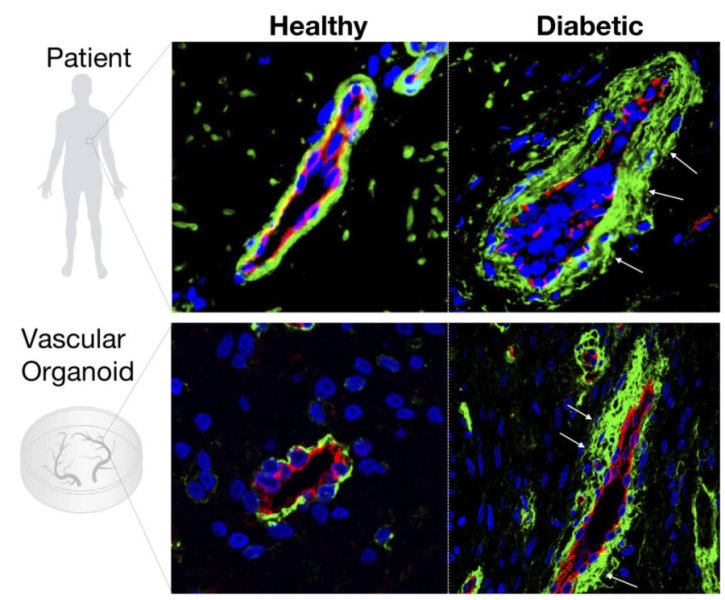
Diabetic blood vessel changes in patients and human vascular organoids. The basement membrane (green) around the blood vessels (red) is massively enlarged in diabetic patients (white arrows). The human vascular organoids that were made “diabetic” in the laboratory can now be used as diabetic model to identify new treatments. Credit: IMBA
Artificial Intelligence Applied To The Genome Identifies An Unknown Human Ancestor
January 16, 2019: Center for Genomic Regulation
By combining deep learning algorithms and statistical methods, investigators from the Institute of Evolutionary Biology (IBE), the Centro Nacional de Análisis Genómico (CNAG-CRG) of the Centre for Genomic Regulation (CRG) and the Institute of Genomics at the University of Tartu have identified, in the genome of Asian individuals, the footprint of a new hominid who cross bred with its ancestors tens of thousands of years ago.
Modern human DNA computational analysis suggests that the extinct species was a hybrid of Neanderthals and Denisovans and cross bred with Out of Africa modern humans in Asia. This finding would explain that the hybrid found this summer in the caves of Denisova -- the offspring of a Neanderthal mother and a Denisovan father -- was not an isolated case, but rather was part of a more general introgression process.
The study, published in Nature Communications, uses deep learning for the first time ever to account for human evolution, paving the way for the application of this technology in other questions in biology, genomics and evolution.
Humans had descendants with an species that is unknown to us
One of the ways of distinguishing between two species is that while both of them may cross breed, they do not generally produce fertile descendants. However, this concept is much more complex when extinct species are involved. In fact, the story told by current human DNA blurs the lines of these limits, preserving fragments of hominids from other species, such as the Neanderthals and the Denisovans, who coexisted with modern humans more than 40,000 years ago in Eurasia.
Now, investigators of the Institute of Evolutionary Biology (IBE), the Centro Nacional de Análisis Genómico (CNAG-CRG) of the Centre for Genomic Regulation (CRG), and the University of Tartu have used deep learning algorithms to identify a new and hitherto-unknown ancestor of humans that would have interbred with modern humans tens of thousands of years ago. "About 80,000 years ago, the so-called Out of Africa occurred, when part of the human population, which already consisted of modern humans, abandoned the African continent and migrated to other continents, giving rise to all the current populations," explained Jaume Bertranpetit, principal investigator at the IBE and head of Department at the UPF. "We know that from that time onwards, modern humans cross bred with Neanderthals in all the continents, except Africa, and with the Denisovans in Oceania and probably in South-East Asia, although the evidence of cross-breeding with a third extinct species had not been confirmed with any certainty."
Deep learning: deciphering the keys to human evolution in ancient DNA
Hitherto, the existence of the third ancestor was only a theory that would explain the origin of some fragments of the current human genome (part of the team involved in this study had already posed the existence of the extinct hominid in a previous study). However, deep learning has made it possible to make the transition from DNA to the demographics of ancestral populations.
The problem the investigators had to contend with is that the demographic models they have analysed are much more complex than anything else considered to date and there were no statistic tools available to analyse them. Deep learning "is an algorithm that imitates the way in which the nervous system of mammals works, with different artificial neurons that specialise and learn to detect, in data, patterns that are important for performing a given task," stated Òscar Lao, principal investigator at the CNAG-CRG and an expert in this type of simulations. "We have used this property to get the algorithm to learn to predict human demographics using genomes obtained through hundreds of thousands of simulations. Whenever we run a simulation we are travelling along a possible path in the history of humankind. Of all simulations, deep learning allows us to observe what makes the ancestral puzzle fit together."
It is the first time that deep learning has been used successfully to explain human history, paving the way for this technology to be applied in other questions in biology, genomics and evolution.
An extinct hominid could explain the history of humankind
The deep learning analysis has revealed that the extinct hominid is probably a descendant of the Neanderthal and Denisovan populations. The discovery of a fossil with these characteristics this summer would seem to endorse the study finding, consolidating the hypothesis of this third species or population that coexisted with modern human beings and mated with them. "Our theory coincides with the hybrid specimen discovered recently in Denisova, although as yet we cannot rule out other possibilities," said Mayukh Mondal, an investigator of the University of Tartu and former investigator at the IBE.
Mayukh Mondal, Jaume Bertranpetit, Oscar Lao. Approximate Bayesian computation with deep learning supports a third archaic introgression in Asia and Oceania. Nature Communications, 2019; 10 (1) DOI: 10.1038/s41467-018-08089-7
Disclaimer: These articles are not intended to provide medical advice, diagnosis or treatment. Views expressed here do not necessarily reflect those of Pittwater Online News or its staff.